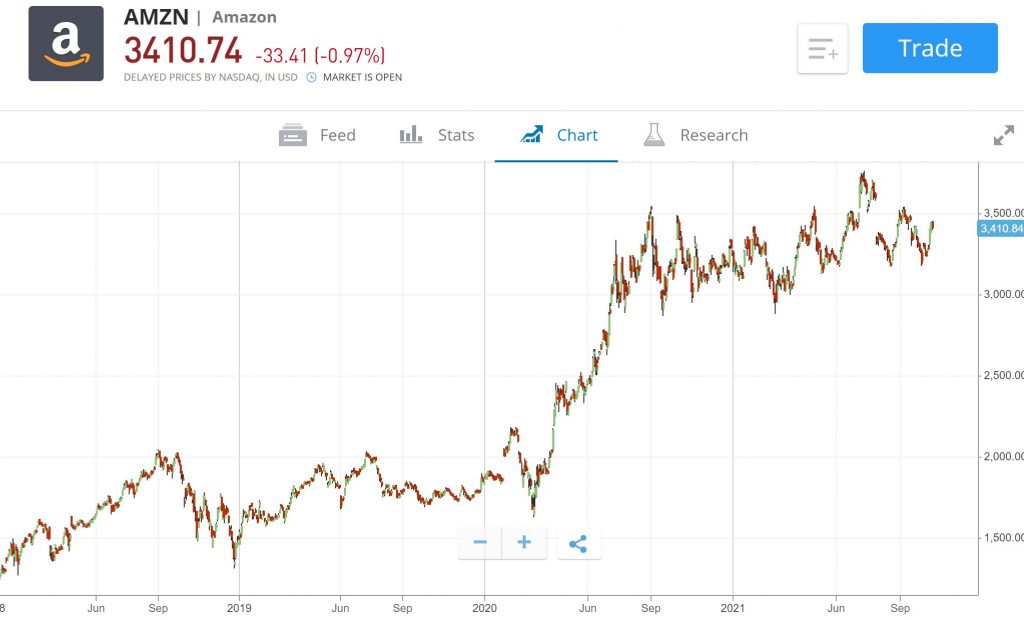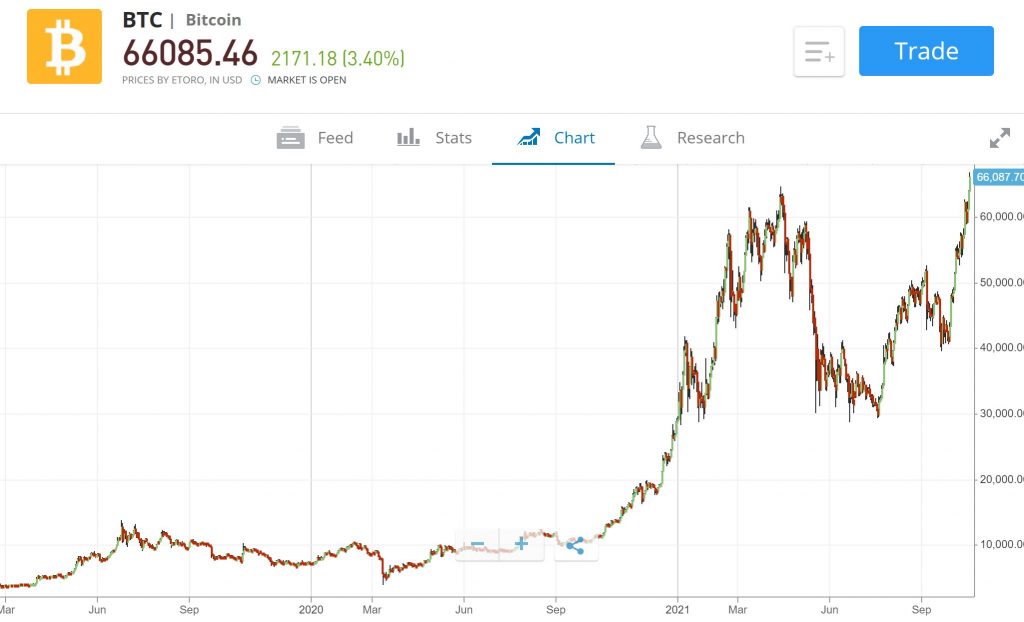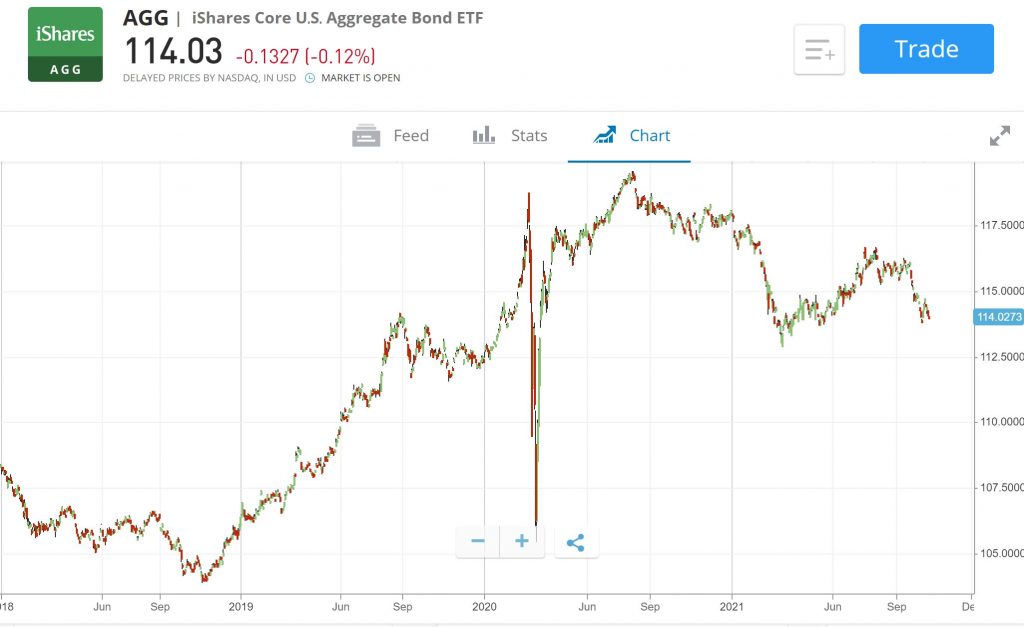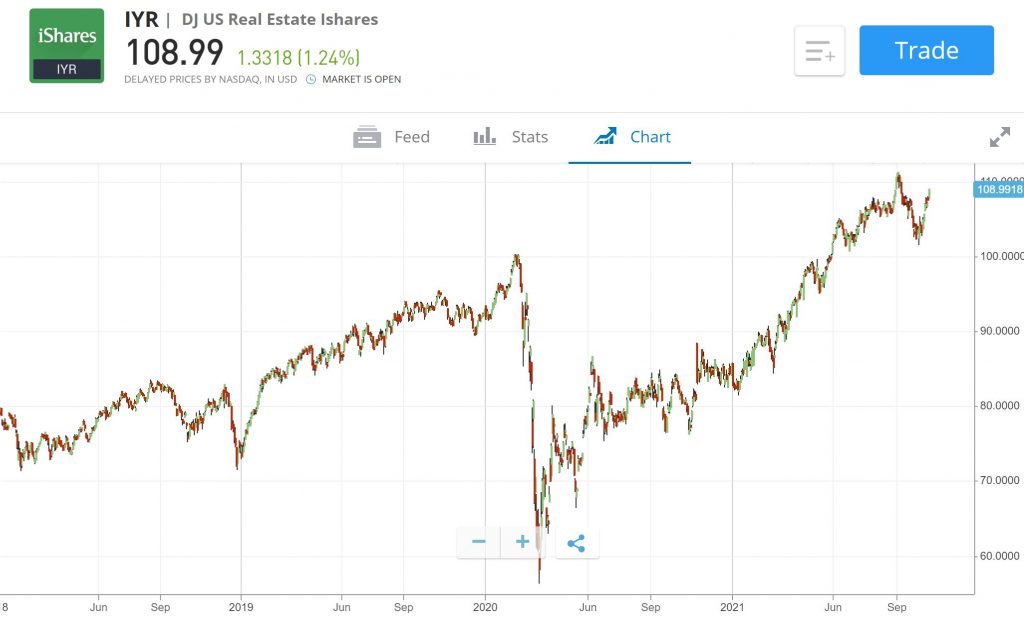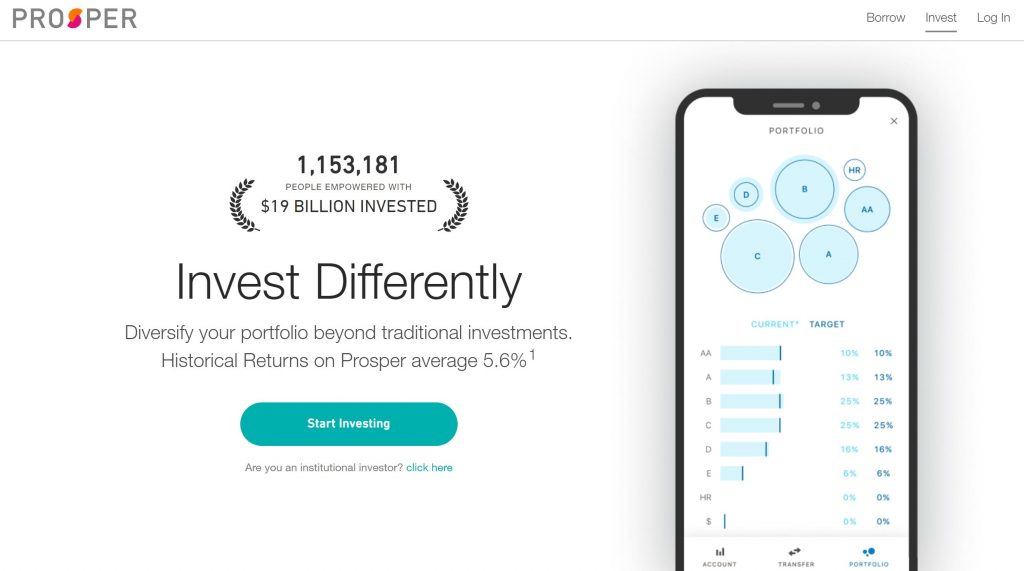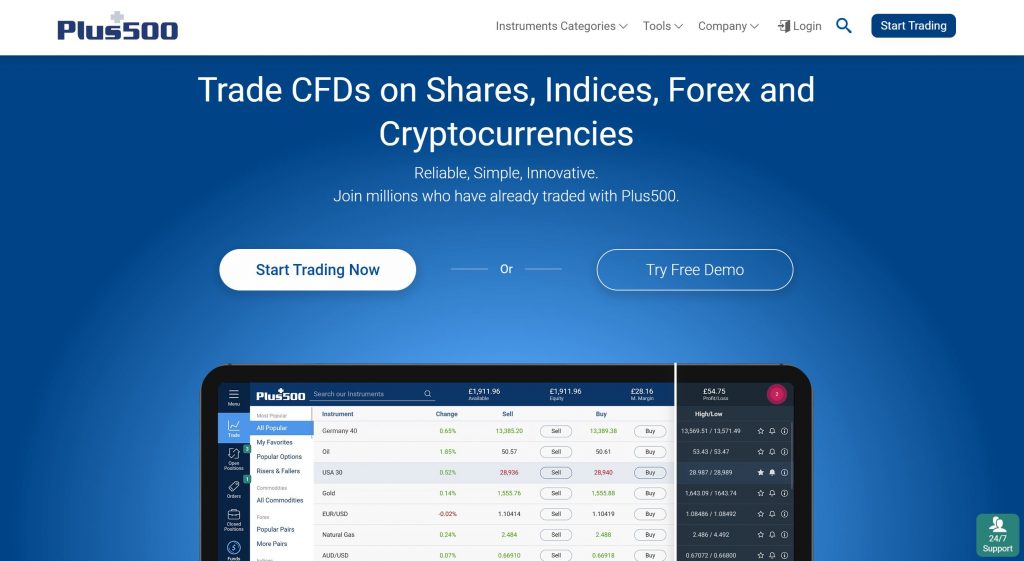Investing your money is one of the best ways to build wealth over time. But for new investors, deciding which investments to invest in and how can be tricky.
In this guide, we’ll highlight the 10 best investments in 2021. We’ll also explain all of the different types of investments available to you – from stocks and ETFs to cryptocurrency and options – and review top brokers you can invest with today.
The 10 Best Investments in 2021 Overview
We picked out the 10 best investments in 2021 that offer a mix of risk and reward. Add one to your portfolio or invest in them all to create a diversified portfolio from scratch:
- Vanguard S&P 500 ETF (VOO) – Invest in the 500 Biggest US Companies
- Amazon shares (AMZN) – Best Individual Stock to Buy in 2021
- Bitcoin (BTC) – Best Cryptocurrency Investment
- iShares Core U.S. Aggregate Bond ETF (AGG) – Best Bond ETF
- SPDR S&P China ETF (GXC) – Best Fund for Investing in China
- 3M shares (MMM) – Best US Dividend Stock
- iShares U.S. Real Estate ETF (IYR) – Best ETF for REIT Investing
- Prosper P2P Loans – Best P2P Loan Investing Platform
- Global X Blockchain ETF (BKCH) – Invest in Miners, Exchanges, and Blockchain Tech
- Vanguard Russell 2000 Growth ETF (VTWG) – Small-cap Stocks with High Growth Potential
The Best Investments in 2021 Reviewed
Let’s take a closer look at each of the 10 best investments we recommend and why they might be a good choice for your portfolio.
1. Vanguard S&P 500 ETF (VOO) – Investments in the 500 Biggest US Companies 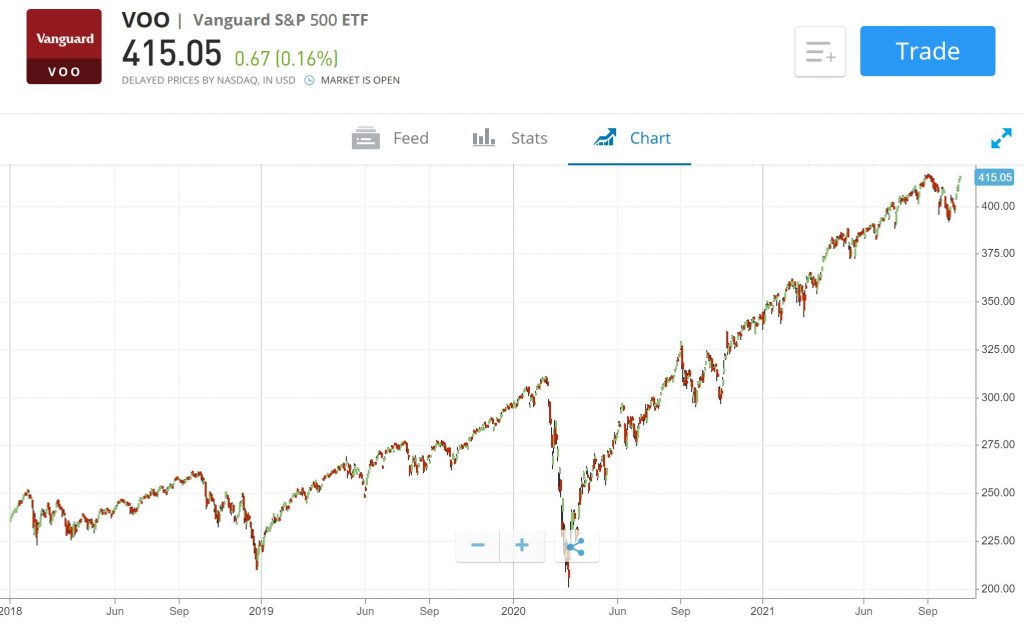
The Vanguard S&P 500 ETF (VOO) is the world’s single largest ETF by assets under management. It’s designed to faithfully track the S&P 500 stock index, which represents the 500 biggest companies in the US. So, when you own this ETF, you’ll own pieces of companies like Apple, Microsoft, Tesla, Visa, Netflix, Pfizer, Walmart, Goldman Sachs, and many more.
The Vanguard S&P 500 ETF is our top pick – and the top pick of investors around the world – because it has an extremely low expense ratio. You’ll pay just 0.03% of your total investment in management fees each year. Considering that the fund has an impressive one-year performance of 29.96%, that’s a pretty low-cost investment.
2. Amazon shares (AMZN) – Best Individual Stock to Buy in 2021
If we had to recommend one individual company’s shares to buy right now, we’d pick Amazon (AMZN). This tech behemoth has more than doubled in value since the start of 2020. While the shares have traded relatively flat since the start of this year, there are still lots of reasons to be bullish about Amazon’s potential.
For one thing, the e-commerce market that Amazon is so dominant in is still growing. For another, Amazon’s cloud computing business, Amazon Web Services, is years ahead of competing cloud platforms in terms of technology and profits. Amazon is also leading the edge of new delivery technologies, which could give this company a huge boost against competitors in the US and beyond.
3. Bitcoin (BTC) – Best Cryptocurrency Investments
Given the massive growth in cryptocurrency in recent years, it only makes sense to include digital coins in your investment portfolio. While there are many promising currencies to choose from, we think Bitcoin (BTC) – the original crypto – is still the best investment.
That’s because Bitcoin remains one of the only cryptocurrencies that’s accepted everywhere that accepts crypto payments. Bitcoin is already considered highly trustworthy, and any regulation that governments put on the coin would likely spur wider use rather than restrict Bitcoin transactions.
Crypto investors seem to agree with us: Bitcoin is up 123% since the start of the year. That said, it’s worth keeping in mind that Bitcoin is much more volatile than many of our other recommendations. So, you’ll need a strong stomach if you want to invest in this cryptocurrency.
Note that you can also check which exchanges have the best Bitcoin Accounts for you to choose from. Important to pick one which is trustworthy and with lesser taxes.
4. iShares Core US Aggregate Bond ETF (AGG) – Best Bond ETF
Bonds offer a relatively safe investment as well as reliable payouts. Rather than pick just one bond, though, we think investors’ best bet is to invest in as many as possible. That’s why we recommend the iShares Core US Aggregate Bond ETF (AGG) – one of the top bond funds available today.
This bond ETF holds more than 9,800 bonds, around 38% of which are highly reliable US treasury notes. It also has a low 0.04% expense ratio, which is good news for investors who don’t want to pay much to diversify their bond holdings.
The iShares Core US Aggregate Bond ETF hasn’t fared all that well in today’s low-interest rate environment. Over the last 12 months, the fund lost 0.93% of its value. But don’t let that deter you – this fund could provide an important safety net in your portfolio if the stock market takes a turn for the worse.
5. SPDR S&P China ETF (GXC) – Best Fund for Investing in China
The SPDR S&P China ETF (GXC) is one of the best investments you can make for adding exposure to Chinese companies. This fund invests in more than 900 different companies, including Chinese tech giants like Tencent, Alibaba, JD.com, and NIO.
This fund has lost 5% of its value over the past year due to China’s crackdown on big companies. However, that trend is unlikely to last. The companies inside this ETF have an astounding average expected EPS growth of 13.75% over the next 3 years. Plus, investing in Chinese stocks offers some diversification since the US and Chinese markets often move in different directions.
6. 3M shares (MMM) – Best US Dividend Stock
Dividend stock investing offers reliable income as well as the prospect for share price appreciation. There’s no stock that meets those two wealth drivers better than 3M (MMM), which pays out a 3.25% dividend each year and which gained 7.0% in value over the past 12 months.
While 3M’s dividend yield might not be as high as that of some oil and gas companies, we recommend 3M because it’s business is built to last. The company recently underwent a restructuring that cut costs and added product lines in healthcare and software. 3M isn’t likely to see huge growth, but it’s business should hum along for many years to come.
7. iShares US Real Estate ETF (IYR) – Best ETF for REIT Investing
The iShares US Real Estate ETF (IYR) offers a simple way to invest in real estate, without making a huge down payment and taking out a mortgage. With this ETF, you can invest in 86 different REITs and real estate companies, which collectively represent tens of thousands of residential and commercial properties across the US.
The iShares US Real Estate ETF benefited from the real estate boom over the past two years. Over the last 12 months, the fund has gained an impressive 30.8%.
One of the things that we especially like about this ETF is that its real estate holdings are diversified. Some of the fund’s gains come from individual homeowners paying their mortgages. Some come from businesses paying rent. And some come from developers buying up land and transforming it into new communities and offices.
8. Prosper P2P Loans – Best P2P Loan Investing Platform
Peer-to-peer (P2P) lending gives you the opportunity to earn interest on your cash, similar to how a bank earns interest from the loans it makes to customers. There are several P2P lending platforms you can turn to for facilitating loans, but Prosper is one of our favorites.
With Prosper, you can lend out as little as $25 at a time and make loans as short as 3 years. You’ll receive payouts monthly as borrowers make payments on your loan, and returns can be as high as 14% per year for higher-risk loans. Prosper also makes it easy to see how risky individual borrowers are, so you can decide for yourself how much risk you’re willing to take on.
9. Global X Blockchain ETF (BKCH) – Investments in Miners, Exchanges, and Blockchain Tech
The Global X Blockchain ETF (BKCH) is a unique fund that gives you exposure to the cryptocurrency and blockchain technology more generally. Instead of investing in individual currencies like Bitcoin, this ETF invests in companies like miners, crypto exchanges, and blockchain software developers.
The fund’s biggest holdings include Marathon Digital, Riot Blockchain, and Coinbase. In addition, it owns shares of legacy payments companies like Visa and PayPal, both of which have thrown themselves into cryptocurrency payments in the past few years.
The Global X Blockchain ETF’s performance is closely correlated with the fate of Bitcoin, but it’s also much less volatile. Since the fund launched in July, it’s up 42%.
10. Vanguard Russell 2000 Growth ETF (VTWG) – Small-cap Stocks with High Growth Potential
The Vanguard Russell 2000 Growth ETF (VTWG) tracks the performance of the Russell 2000 stock index. This index includes more than 2,000 small-cap stocks, many of which attract investors for their enormous growth potential. Importantly, the Russell 2000 also moves independently of the larger S&P 500 index, so investing in this fund offers some diversification even as you pad your portfolio with US stocks.
The Vanguard Russell 2000 Growth ETF includes holdings in companies like Asana, Crocs, Intellia Therapeutics, and Tetra Tech. It’s produced gains of more than 33% for investors over the past 12 months and has a low expense ratio of just 0.15%.
The Best Investment Platforms in 2021
Whether you want to buy stocks, ETFs, bonds, cryptocurrency, forex, or other assets, you’ll need an investment platform to do so. There are hundreds of brokerage platforms to choose from, which differ in everything from what assets they offer to how much they cost to how easy it is to set up a brokerage account.
To help you decide which brokerage is right for you, we’ll highlight 4 of our favorite investment platforms in 2021 that you can start investing with today:
1. eToro – Overall Best Investment Platform for Stocks, ETFs, Crypto & More 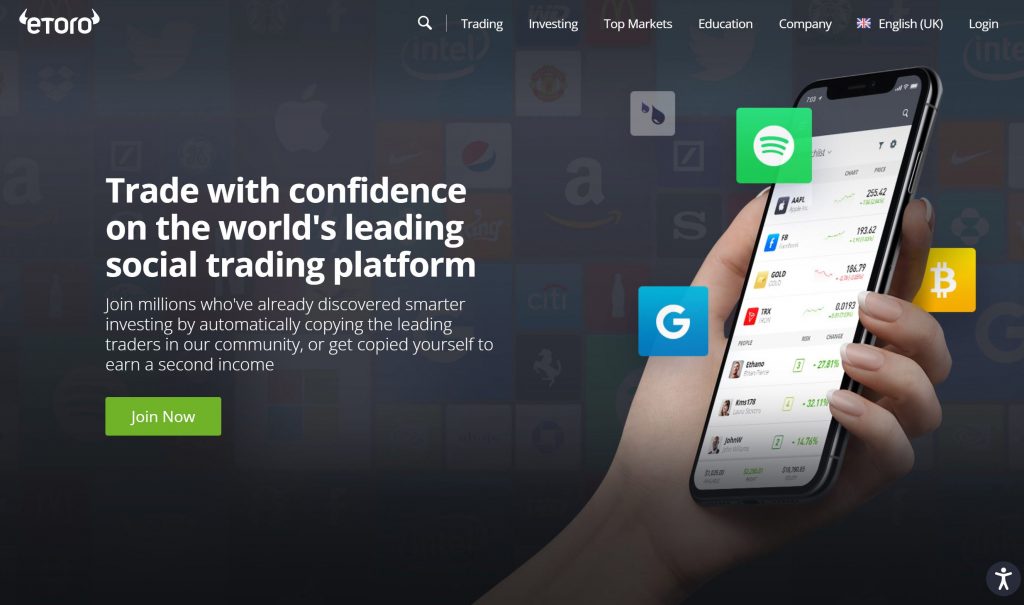
eToro is our top pick for new investors in search of a brokerage platform. This brokerage offers nearly everything you could want: more than 2,000 stocks, nearly 150 ETFs, forex and commodity futures, bonds, cryptocurrency, and more. Notably, eToro has not only stocks from the US, but also company shares from the UK, Europe, and Asia.
A big part of what makes eToro stand out for investing is that the platform offers zero commissions on stock and ETF trades. You can buy and sell shares completely fee-free. eToro also has some of the lowest fees we’ve seen for cryptocurrency investing, and it offers a built-in cryptocurrency wallet so you can store your digital coins safely.
eToro makes it easy for new investors to get started, even if you only have a small amount to invest. You can open a new account with as little as $50, and eToro lets you buy fractional shares of expensive stocks. Plus, eToro has plenty of portfolio and analysis tools to help you decide on the right investments for you.
eToro fees:
| Commission | 0% |
| Deposit Fee | None |
| Withdrawal fee | $5 |
| Inactivity fees | $10 per month after 12 months |
| Pros | Cons |
| 100% commission-free stock and ETF trading | Few advanced tools for technical analysis |
| Open an account with just $50 | Small $5 fee per withdrawal |
| Trade more than 2,000 global stocks | |
| Very low fees for crypto trading | |
| Excellent portfolio and analysis tools |
2. Capital.com – Trade Over 3,700 Stocks with No Commission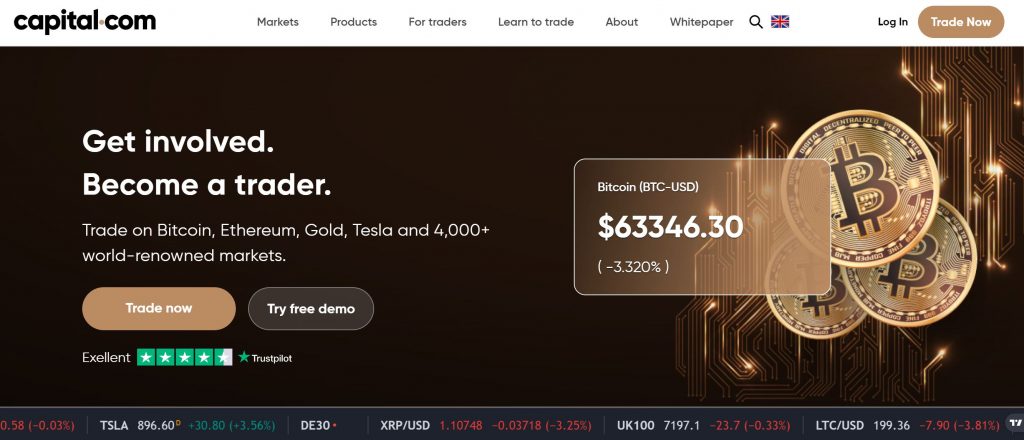
Capital.com is another top investment platform that lets you trade more than 3,700 global stock CFDs along with CFDs for ETFs, cryptocurrencies, forex, commodities, and more. All trading at Capital.com is completely commission-free, and the platform doesn’t charge deposit or withdrawal fees. So, Capital.com is a great choice for investors looking to eliminate fees from their portfolio.
Another thing we love about Capital.com is that it offers an enormous library of resources for new investors. The platform has interactive courses that explain how different assets work and cover the basics of CFD investing. Capital.com also has detailed guides to stock trading and investment strategies, so you can grow your financial knowledge as you invest.
Capital.com lets you open a new investment account with as little as $20. The brokerage accepts credit and debit cards for payment to make things simple. Plus, Capital.com has a mobile app so you can check your investments and trade on the go.
Capital.com fees:
| Commission | 0% |
| Deposit Fee | None |
| Withdrawal fee | None |
| Inactivity fees | None |
| Pros | Cons |
| Over 3,700 global shares to buy and sell | Only offers CFD investments |
| No deposit, withdrawal, or inactivity fees | |
| Open an account with just $20 | |
| Educational courses for new investors | |
| Mobile app for trading on the go |
3. AvaTrade – Advanced Research and Analysis Tools for Investing
AvaTrade is a more advanced investment platform that’s suitable for investors looking to take their portfolio to the next level. This platform offers in-depth price analysis tools, including technical charting software, price alerts, and a news feed. Plus, you can sign up for expert market opinions and trade recommendations from AvaTrade’s team of analysts.
AvaTrade only offers CFD trading, and the range of assets you can invest in is more limited than at other platforms. For example, AvaTrade only has around 600 stock CFDs and 60 ETFs. That said, you’ll find more than a dozen of the most popular cryptocurrencies. AvaTrade also offers forex options trading, which you won’t find at most beginner-friendly investment platforms.
Trading with AvaTrade is 100% commission-free and the platform is known for its low fees. You can open an account with $100 and there are no deposit or withdrawal fees. You can fund your account with a debit card, credit card, bank transfer, or a variety of popular e-wallets.
AvaTrade fees:
| Commission | 0% |
| Deposit Fee | None |
| Withdrawal fee | None |
| Inactivity fees | $50 per quarter after 3 months |
| Pros | Cons |
| No commissions or deposit/withdrawal fees | Limited range of stock CFDs available |
| In-depth technical analysis tools | Relatively high inactivity fee |
| Get recommendations from AvaTrade analysts | |
| Supports forex options trading | |
| Open a new account with $100 |
4. Plus500 – User-friendly Investment Platform with Zero Commissions
Plus500 is one of the most user-friendly investment platforms we’ve tested. From sign-up to investing, it’s very simple to use and puts all the investment tools that beginners are likely to need at your fingertips. Among other things, you’ll find a streamlined charting software for analysis, a news feed to highlight market activity, and a sentiment gauge to show you what other investors think about an asset’s prospects.
Helpfully, Plus500 also builds risk management tools into its investment platform. You can create stop-loss orders to manage when your investments are sold, as well as trailing stop orders that help you lock in profits. All of the different order types are clearly explained so there’s no confusion when you’re buying and selling with Plus500.
Plus500 offers trading on nearly 2,000 shares, all as CFDs. The platform also lets you trade cryptocurrencies, forex, commodities, and ETFs as CFDs. All trades are completely commission-free and Plus500 doesn’t charge any deposit or withdrawal fees. You can open a new account with a $100 deposit.
Plus500 fees:
| Commission | 0% |
| Deposit Fee | None |
| Withdrawal fee | None |
| Inactivity fees | $10 per quarter after 3 months |
| Pros | Cons |
| Easy to use investment platform | Only offers CFD investing |
| See what other investors think about an asset | Limited selection of ETFs |
| No commission or withdrawal fees | |
| Nearly 2,000 stock CFDs | |
| Built-in risk management tools |
How to Start your Investments today
Ready to start investing? We’ll walk you through how to get started using eToro, our #1-rated investing platform in 2021. With eToro, it only takes a couple steps to buy your first stock or ETF commission-free:
Step 1: Open an eToro Account
To get started, head to eToro’s website and click ‘Join Now.’ In the sign-up form, enter your email and a username and password for your account. Then check your email for an email from eToro and click on the verification link inside. To complete the registration process, enter your name, phone number, and the basic financial details requested.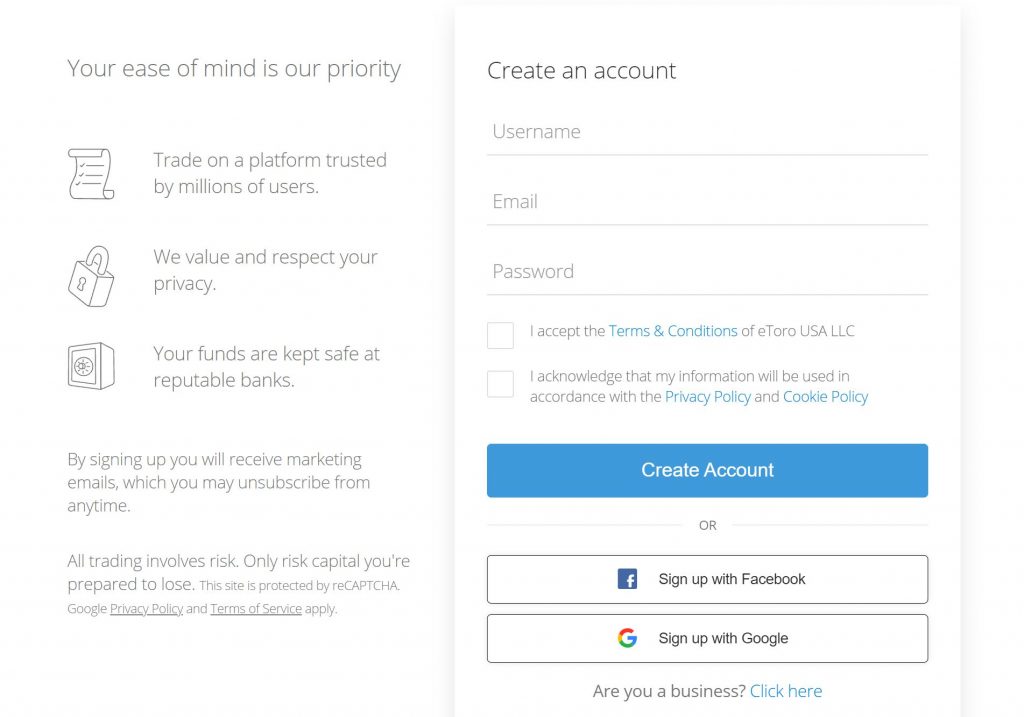
Step 2: Fund Your Investing Account
Next, you can fund your new eToro account with at least $50. eToro accepts debit cards, credit cards, PayPal, Neteller, and Skrill. You can also make a deposit using a bank account if you transfer at least $250.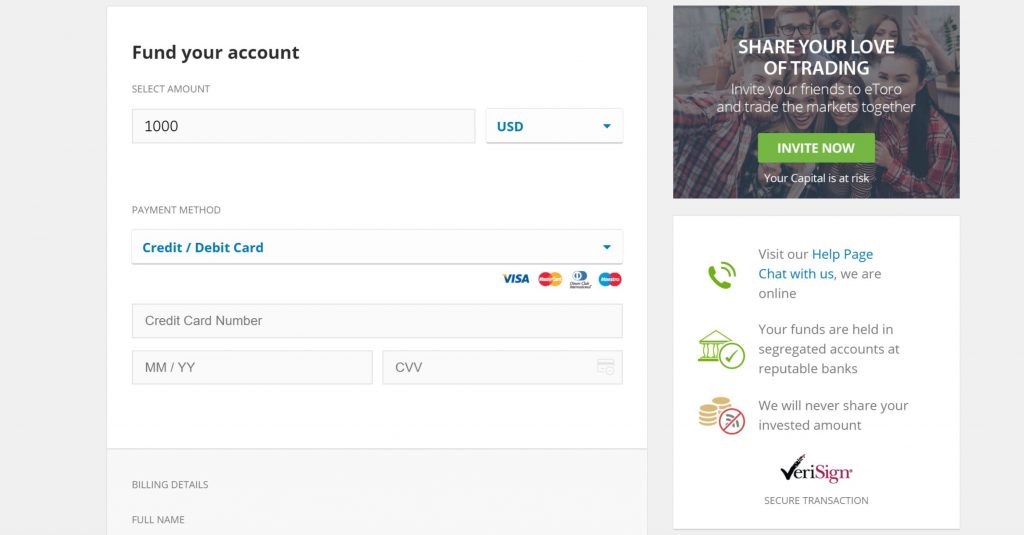
Step 3: Choose an Investment
In the eToro dashboard, you can see all the different investments available to you. Click on one, or search a specific stock or ETF by name – for example, the Vanguard S&P 500 ETF. Then click ‘Trade’ to open a new order form.
Step 4: Buy
In the order form, enter the amount you want to invest. You can also choose stop-loss or take-profit levels to automatically close out your position, although these aren’t required. To complete your investment, click ‘Open Trade.’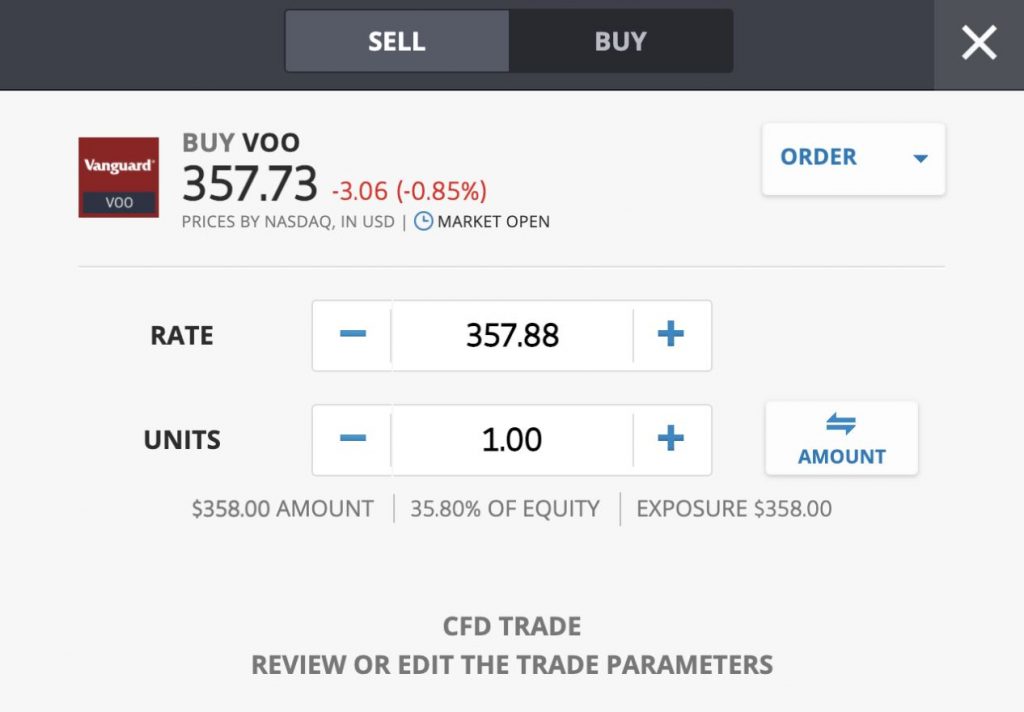
How to Choose the Best Investments For You
With a virtually infinite number of investments to choose from, how do you decide which asset classes, funds, and individual investments are right for your portfolio? We’ll explain some of the most important things to consider when picking your investments.
Consider Your Financial Goals
The first thing to ask yourself when building a portfolio is what that portfolio is for. Are you putting away money for retirement? Investing to buy a home? Or simply trying to get a better rate of return than a savings account might offer?
Your financial goal is important for several reasons. First, it impacts the timescale of your investment. Investing for retirement in 30 years is very different from investing to buy a house in 5 or 10 years.
The shorter your investment time horizon, the more you need to consider how a temporary dip in the market or a recession might impact your plans. Over longer investment horizons, these bumps in the road might not matter until you’re closer to needing to sell your investments.
On top of that, the reason you’re investing will influence your risk tolerance. You might be less willing to invest in high-risk assets if your retirement is on the line than you would be if you’re investing for your vacation fund. On the other hand, you might want to invest more aggressively to meet your savings targets without having to set aside as much money from your paycheck.
Put Together a Diversified Portfolio
Another key thing to consider when assembling your investments is to make sure that your portfolio is diversified. For example, instead of investing solely in stocks, you might invest 50% of your portfolio in stocks, 25% in bonds, 15% in real estate, and 10% in cryptocurrency.
Diversification helps reduce your risk by spreading your money across investments that don’t all move in the same direction in response to news and events. For example, the real estate market is relatively independent from the stock market – so REITs and home prices might stay high during a bear market, buoying your portfolio. In effect, diversification reduces the risk that your whole portfolio will suffer during a downturn in one specific market.
The best way to diversify is by investing in several different asset classes. However, you can also diversify within asset classes. For stocks, for example, you can invest in both growth stocks and dividend stocks, or in a mix of stocks from the tech, finance, consumer goods, and auto sectors. You can also diversify geographically by investing not only in US stocks, but also in stocks from Europe and Asia.
ETFs, mutual funds, and investment trusts offer a simple way to diversify since most of these funds contain hundreds or thousands of individual investments.
Balancing Returns vs. Risk
It’s also important to diversify your portfolio in terms of the risk you’re taking on. High-risk investments can offer higher returns than low-risk investments, but they can also lead to bigger losses if your investment doesn’t work out the way you planned.
The risk involved in any individual investment is somewhat subjective. However, you can think of it generally as the maximum amount of value that an asset could lose while you’re holding it. You can gauge how much an asset might drop – or how quickly it might drop – by looking at its historical price fluctuations.
Once again, the amount of risk that you are willing to take on should be determined by your investing goals. Younger investors who are planning to hold onto an investment for decades might be willing to take on more risk. Older investors, or investors who need to liquidate their investments for cash in the near future, might want to accept lower returns to lower their investment risk.
In any case, never invest more than you can afford to lose, even in relatively safe investments.
Types of Investments
Let’s explore some of the most popular types of investments, including the advantages and disadvantages of each.
Stocks
Stocks are shares of individual companies. When you buy stock shares, you own a piece of the company and you’re entitled to any profits it pays out to investors in the form of dividends.
Stocks are the most popular type of investment, in part because there are so many different types of stocks to choose from.
Small-cap & Large-cap Stocks
One of the ways that stocks are commonly categorized is by market capitalization. This is the total value of all shares that a company has issued. Large-cap stocks have market caps over $200 billion – this category includes most stocks in the S&P 500 stock index, like Apple and Amazon.
Small-cap stocks have market caps under $2 billion. Many of the biggest US small-cap stocks are included in the Russell 2000 index, but there are thousands of small-cap stocks that aren’t in the index.
In general, large-cap stocks are considered to be steady giants, with relatively low volatility and lower risk than small-cap stocks. Small-cap stocks, on the other hand, have more room for growth but also involve more risk.
Growth Stocks
Growth stocks are stocks that are expected to grow at a much faster than average rate. Many are shares from young companies with a lot of room for expansion. Growth stocks are typically considered high-risk, high-reward stocks.
Value Stocks
Value stocks are shares that the market is undervaluing. Stocks can be undervalued because investors don’t see their full potential, because of negative news, or because of temporary business problems. Undervalued stocks can represent a bargain for investors, but keep in mind that it can take a long time for these shares to reach their “true” value.
Dividend Stocks
Dividend stocks are any stocks that pay out dividends to investors. These stocks can be attractive because they offer fixed income, which you can use to reinvest or as cash to spend on everyday expenses. Dividend stocks can be directly compared by their yield, which is the annual dividend payout divided by the share price.
US & International Stocks
While the US is home to many of the biggest and most valuable stocks in the world, one way to diversify is to invest in international stocks. You can buy and sell shares from the UK, Europe, Australia, Japan, China, and more.
IPOs
Initial public offerings (IPOs) happen when a young company first lists its shares on the stock market. IPOs can be a chance to get in on a company’s stock at a great price. However, IPOs can also be risky because it’s not always clear how investors will react to the new shares.
ETFs
ETFs, or exchange-traded funds, are baskets of assets that trade on a stock exchange alongside stocks. When you invest in an ETF, you invest in everything inside the fund. That can be hundreds of different stocks, thousands of different bonds, or something else altogether. In fact, there are not only stock and bond ETFs, but also forex ETFs, real estate ETFs, cryptocurrency ETFs, options ETFs, and more.
One of the most popular types of ETFs you’ll find are index funds like the Vanguard S&P 500 ETF (VOO). These ETFs invest in major stock market indices, enabling you to invest in the whole stock market or individual sectors without picking and choosing individual stocks.
Mutual Funds
Mutual funds are similar to ETFs in that they are baskets of different securities, such as stocks and bonds. Unlike ETFs, though, mutual funds don’t trade on stock exchanges. To purchase a mutual fund, you must go through the brokerage or firm that runs the fund. In general, mutual funds have higher fees and higher minimum investment thresholds compared to ETFs.
Investment Trusts & REITs
Investment trusts are a lot like ETFs, and you’ll mostly see them in the UK rather than in the US. The exception to this is real estate investment trusts, or REITs, which are common in the US.
REITs are essentially property management companies. They can own properties, land for development, mortgages, leases, and more. An REIT might, for example, own hundreds of commercial buildings and collect rent from tenants. Most REITs pay dividends to shareholders.
Options
Stock options are contracts that give you the option – but not the obligation – to buy or sell a stock at a predetermined price. To understand how options work, let’s look at an example.
Say you purchase a call option for Amazon, which lets you buy 100 shares of Amazon for $3,500 before a certain date in the future. If Amazon shares rise to $3,600 apiece, you can exercise your option to buy shares for $3,500 and then immediately sell them for a $100 profit each. On the other hand, if Amazon shares remain below $3,500, then your options contract will expire worthless.
Options are complex financial instruments, and they’re best suited for experienced and aggressive investors.
Futures
Futures work similarly to options, except that you are obligated to exercise the purchase specified in the contract on the expiration date. Futures cannot expire worthless like options contracts can.
Futures are mainly used for commodities trading in oil, gold, and agricultural products.
Bonds
Bonds are essentially I.O.U notes issued by businesses and governments. When you purchase a bond, you’re entitled to receive monthly, quarterly, or annual interest payments from the bond issuer. On a bond’s maturity date, you’ll receive the entire principal of your loan – known as a bond’s face value – back.
Bonds are considered to be very safe investments, especially if you hold bonds from major companies or governments. The value of bonds, however, is closely tied to interest rates.
Real Estate Investments
Real estate is a popular investment for diversifying your portfolio because ups and downs in the real estate market are relatively uncorrelated with changes in the stock market. You can invest in real estate by buying property yourself, but you can also invest in REITs.
Forex
Forex, or foreign exchange, is currency. When you invest in forex, you can hedge against the future value of the US dollar or another currency, such as the British pound, the Japanese yen, or the euro.
Cryptocurrency Investments
Cryptocurrencies like Bitcoin, Ethereum, Ripple, Litecoin, and others operate much like forex – you can exchange from US dollars to Bitcoin, or from one cryptocurrency to another. Cryptocurrencies can rise and fall in value extremely quickly, so they’re best-suited for investors who have a strong stomach.
P2P Lending
Peer-to-peer (P2P) lending involves lending out money directly to individuals, rather than putting money in a savings account and then letting the bank lend your money out. The advantage of P2P lending is that you can collect much higher interest rates than you would with a typical bank account. However, your risk is also higher, since you could lose your investment if the borrower defaults.
There are many P2P lending platforms available today. Some of the most popular include Prosper, Funding Circle, Kiva, and Peerform.
Crowdfunding
Crowdfunding is a way to invest in startups in exchange for equity. Depending on the terms of a crowdfunding offer, you may also make a loan to a company that will be paid back like a bond. The advantage of crowdfunding is that you can get in on promising young companies early on. However, it can also be risky since these companies don’t have a proven track record.
Some of the most popular crowdfunding platforms today include Seedinvest, StartEngine, and Wefunder.
CFDs
Contracts for difference (CFDs) are a type of financial instrument that give you exposure to the price of an asset without actually owning it. You can buy CFDs for stocks, ETFs, options, forex, cryptocurrency, and virtually anything else. CFDs are often used for short-term trading, but they can also be used for long-term investing.
Robo Advisors
Robo advisor platforms like Wealthfront, Betterment, Acorns, and others are meant to serve as digital financial advisors. These platforms invest in stock and bond ETFs on your behalf and manage your portfolio over time. Robo advisors can be a good option if you want to invest and forget about your portfolio for a while, but they are typically more expensive than investing on your own.
Other Investments
When building a diversified portfolio, it’s okay to think outside the box. Alternative investments to traditional financial instruments include art, antiques, and collectibles, among other things. Just be sure that you have a clear understanding of the items you’re buying and selling when investing in these niche markets.
Conclusion
Finding the best investments for your portfolio doesn’t have to be hard. With our list of the top 10 investments in 2021, you can build a portfolio that puts you on the right path to meet your financial goals. To get started investing today, check out eToro and invest in stocks &ETFs commission-free!



